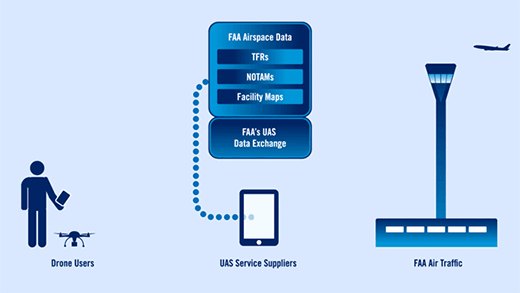
The speed and efficiency of its automated Low Altitude Authorization and Notification Capability (LAANC) authorization system has permitted the Federal Aviation Administration (FAA) to issue its millionth permit to drone pilots in record time.
The FAA said it had passed the milestone this month, less than four years after it launched LAANC to automate the process of issuing drone pilots permission to fly in restricted airspaces or in controlled circumstances. The app-based system aims to integrate UAVs into the broader world of aerial activity through an automatic link-up between the FAA, controllers, and pilots requesting LAANC flight authorization.
Under Part 107 of the Federal Aviation Regulations, UAV operators must obtain FAA approval to fly in restricted areas of air traffic control – a process that, when carried out manually, often took weeks or more. After automating that in 2018 with the launch of LAANC, drone pilots have been able to almost immediately obtain permission (or refusal) to access to controlled airspaces at or below 400 feet.
Last year the process was also extended to night flying in such zones. In addition to that, the FAA modified the mapping of controlled skies in LAANC, which it said was designed to provide greater liberty to drone pilots. As a result, it said, operators “have more areas they can fly in since the FAA has divided the airspace into smaller segments.”
The speed of the application has been hailed by aviation participants on all sides for accelerating the effort to weave routine UAVs operations more tightly into the fabric of wider air activities. In addition to rapidly determining whether requesting drone pilots can be authorized to fly in controlled air spaces, LAANC also provides maps informing operators where they can and cannot fly, and feeds air traffic professionals with data of where permitted craft are aloft in otherwise restricted spaces.
“This system has allowed drone pilots to gain timely access to busy airspace without sacrificing safety,” said Teri L. Bristol, the chief operating officer of the FAA’s Air Traffic Organization. “We are grateful to everyone who helped us reach this milestone safely.”
Requests are checked against multiple airspace sources in the FAA’s UAS Data Exchange, including UAS Facility Maps, Special Use Airspace data, Airports and Airspace Classes, Temporary Flight Restrictions, and Notices to Operators.
The application is used by both private and business drone pilots to seek LAANC permission in near-real time, or up to 90 days before making their flight. The system covers 542 air traffic facilities serving approximately 735 airports.
FTC: We use income earning auto affiliate links. More.




Comments